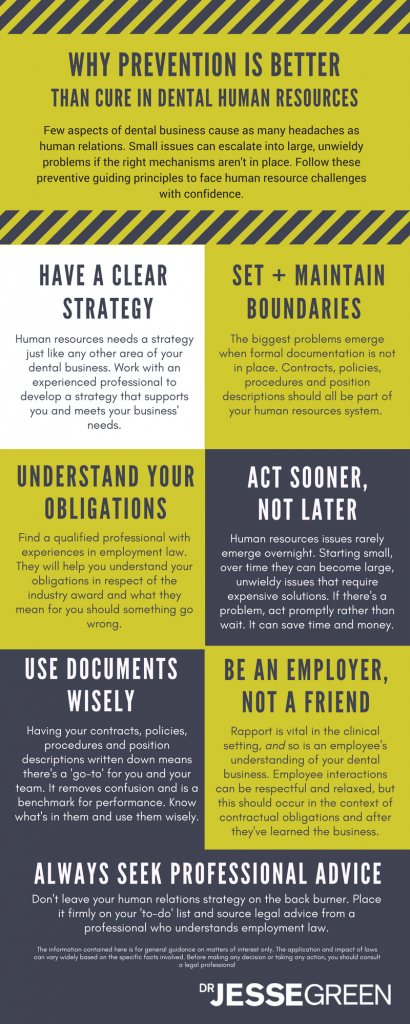There are few aspects of dental business that cause the concerns human relations do.
When personalities and people are at work, the potential for small issues to escalate into bigger problems multiplies.
This is especially true if the right human resource mechanisms aren’t in place.
Without robust structures and systems, dental business owners can find themselves in murky water.
So how do we avoid these situations?
By taking the same approach we do with our patients, namely one that espouses prevention over cure.
Here are some simple preventive guiding principles to adopt when it comes to dental human resources.
Have A Clear Strategy
I’m a firm believer in the value of strategy in business. It’s an approach that applies to human resources.
Without a clear strategy, there’s a greater chance small issues morph into larger, unwieldy problems with no easy solution.
A human resources strategy is not one you try to develop solo.
Instead, it is wise to seek counsel from an experienced professional.
They will take time to understand your specific business. Then show how a human resources strategy should support it.
Set And Maintain Clear Boundaries
For the best dental human relations, it is critical clear boundaries are set and maintained – from day one.
Why?
Because the biggest problems emerge when there’s no documentation against which people and performance are held accountable.
Clear boundaries that articulate roles and responsibilities are written into position descriptions.
The way things get down is documented in procedures.
How things work in your dental business are communicated in policies.
Together, all parties arrive at a shared understanding.
Avoiding human resource catastrophes means documenting the employee or contractor relationship in a formal agreement you understand.
That way terms and conditions are clear to both parties.
A regularised process of performance and conduct management is just another piece of the puzzle.
Clear boundaries leave no doubt in the mind of your employee or contractor about where they stand.
While not a complete safeguard against poor performance, you’ll have the tools by which it can be addressed.
Understand Your Legal Obligations
A highly contentious topic discussed in dental forums is the question around contractor versus employee dentists.
I don’t intend putting forward a view in support of one over another.
What I will say is, while the Health Professionals and Support Services Award 2010 was intended to simplify things, understanding its nuances is complicated.
Your best bet here is finding a qualified lawyer who knows what they’re doing.
He or she can help navigate the tricky waters around the award or an enterprise agreement, if you choose that instead.
In terms of your obligations within award, and as it applies to a contract and each employee, this is essential information.
The bottom line here is: know your obligations.
And get the right help to understand what they mean
Act Sooner Instead of Later
In my recent podcast interview with Canberra-based employment lawyer John Wilson, he confirmed what I already knew.
Human resource issues rarely arise overnight.
Rather, they generally percolate over a period of time, starting with some seemingly innocuous incident that goes unaddressed.
A single event is followed by others, until your back’s up against the wall.
Sound familiar?
Apparently, you’re not alone.
John says there is one question he asks people when they come to him.
What have you done before now to address this situation?
In the majority of cases, people – business owners – have done very little.
They’ve let things slide because they’re too busy, don’t enjoy confrontation, the employee is ‘too valuable’, or they hope it will just go away.
Unfortunately, the head-in-the-sand approach doesn’t work. Ever.
The answer?
Act sooner instead of later.
Use Documentation Wisely
Contracts, policies, procedures and position descriptions means there is something written down you can refer to when calling people to account.
So make sure that’s what you do.
Surprisingly, it’s common for high functioning dental practices to have the right documentation in place, but never refer to it.
There are practical ways this can be done.
Regular performance reviews, policy revision at team meetings, focused sessions on specific topics – these are all doable in the context of any busy dental business.
Be An Employer Not A Friend
It’s tempting to establish a strong personal connection when a new employee joins the team.
While rapport is important, especially in the clinical setting, it’s more important the new team member learns how your business works first.
And this takes time.
New employees must build understanding and observe how things get down first.
Only then is it reasonable to foster more relaxed interaction within the parameters of contractual and legal obligations.
Extending too much leniency opens the door for waters to become murky and expectations confused.
Final Words….
A clear human resources strategy is something often placed on the backburner, but it’s never too soon to take firm steps to implement one.
Rather than working through it alone, get help from a professional with expertise in this area.
Maintain a focus on establishing and maintaining clear boundaries in solid legal documentation you understand.
That way you’ll be well positioned to face any human resources challenge with confidence.
The information contained in this blog is for general guidance on matters of interest only. The application and impact of laws can vary widely based on the specific facts involved. Given the changing nature of laws, rules and regulations, and the inherent hazards of electronic communication, there may be delays, omissions or inaccuracies in information contained in this article. Before making any decision or taking any action, you should consult a legal professional.




